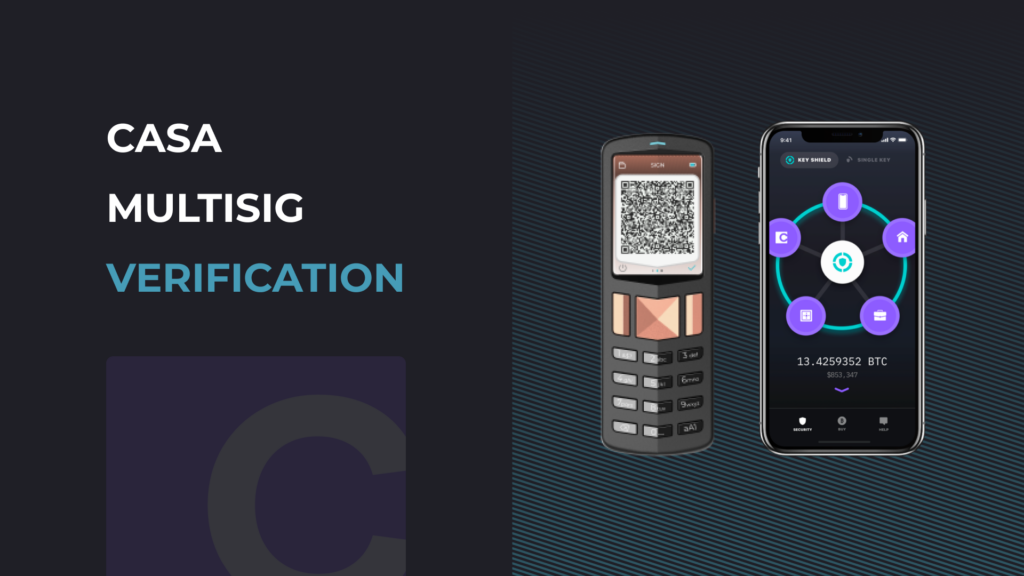
collaborative custody
Casa is one of the Bitcoin ecosystem’s leading collaborative custody services. Using the Casa mobile app, you can create a multi-signature wallet consisting of either:
- 3 keys (Gold Plan) – 1 user secured signing device like Passport, a key stored on the user’s phone (backed up to the cloud), and Casa holding the third key.
- 5 keys (Platinum Plan) – 3 user secured signing devices, a mobile key and a fifth key held by Casa.
With this setup, the user is always the majority key holder, and Casa alone cannot spend any funds from the wallet. Under normal operation, users do not need to interact with the key held by Casa and can authorize transactions themselves using their majority key set. Where the Casa key comes into play is in a scenario where the user loses access to 1 key in the Gold Plan, or 2 keys if using the Platinum Plan. In this scenario, the user can initiate a Recovery transaction to spend, with the help of Casa, their Bitcoin to a new multisig wallet where all keys are accessible once again.
With the release of Passport firmware v2.0.4, we are thrilled to announce that using Passport with Casa is now easier than ever. Passport’s new Extensions menu lets you quickly and easily enable different features that unlock new functionality. Once enabled, the Casa extension adds an additional Casa account screen. From here you can do the typical transaction signing as you would with any other Passport account, but you’ll also notice some Casa specific features, such as ‘Health Check’, that allows you to quickly confirm that Passport is still connected with your Casa account. You’ll also find a customized Casa connection wizard that makes your initial setup a breeze!
Founder’s Edition Passport users fear not, we will be porting all of the new v2.0.4 features to your firmware very soon.

Who is this guide for?
For the reasons outlined above (and many more), Casa functions incredibly well to help many Bitcoiners secure their wealth. This tutorial is for those users that want to leverage the power of a collaborative custody setup like Casa, but at the same time want to minimize the level of trust they place in Casa. The following steps show how to recreate a ‘watch-only’ version of a Casa multisig wallet. This watch-only version of the wallet will be created in the free and Open Source desktop application, Sparrow Wallet. Being a watch-only, Sparrow will not have the ability to spend any funds from within, though we will make a brief mention of the additional steps required to do this later.
There are three main reasons a user might want to carry out these steps:
- To check that Casa is generating receive and change addresses that belong to the wallet created with the three keys provided. Later, we’ll leverage Passport’s ‘verify address‘ scanning feature to make this super simple.
- In preparation for a doomsday scenario in which Casa the company ceased to exist and the user needed to recover their funds without the help of Casa.
- To use the Whirlpool coinjoin service within Sparrow to mix directly into their Casa multisig wallet.

Before we start
The following steps assume a few prerequisites are met. Ensure you meet all three requirements before attempting to complete this tutorial:
- You have a Casa multisig wallet setup and active on your Android or iOS device.
- You have downloaded Sparrow Wallet.
- You have a secure method of transferring sensitive information from your phone to the device running Sparrow Wallet. Examples include Signal, Keybase, or an encrypted notes app like Standard Notes.
Exporting the public keys
To recreate the Casa wallet in Sparrow, we need the public keys from each wallet participant as well as the corresponding derivation path and fingerprint for each. If you’re a Gold plan user, that means you’ll need to check 3 keys, and Platinum users will need to check 5 keys.
Open the Casa app, click on any of the available keys, then tap ‘View Public Keys‘. Copy and paste all information shown into your chosen secure transfer app. Be sure to carefully label which key the information belongs to.
Repeat these steps for every key until you have something that resembles the image below. Depending on how you’ve used the Casa app prior to this guide, your derivation paths may be different to those shown in this guide. Also note the lack of a derivation path for the Casa Recovery Key, the Casa app does not display this information.
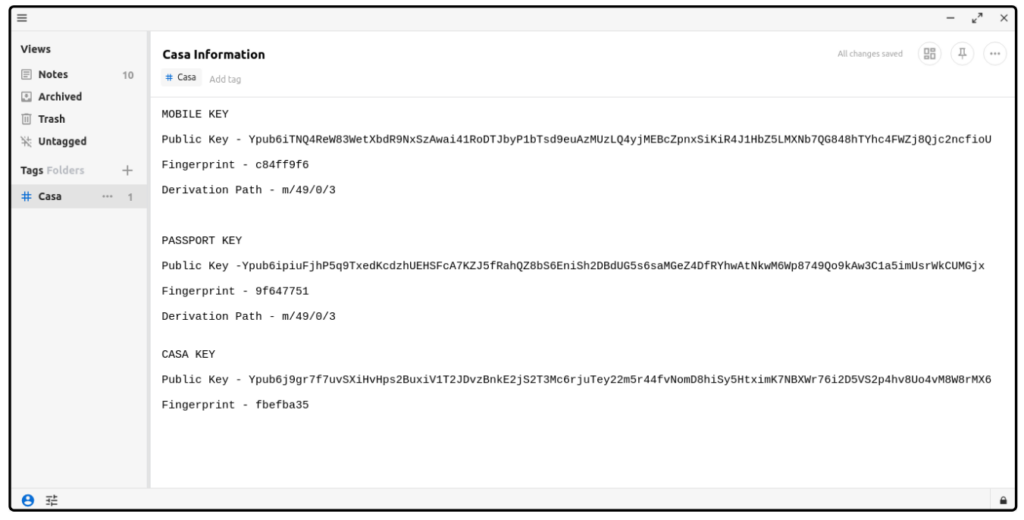
Enter Sparrow
Now that we have the required information from Casa, we can turn our attention to Sparrow. Click File > New Wallet and give the wallet a name
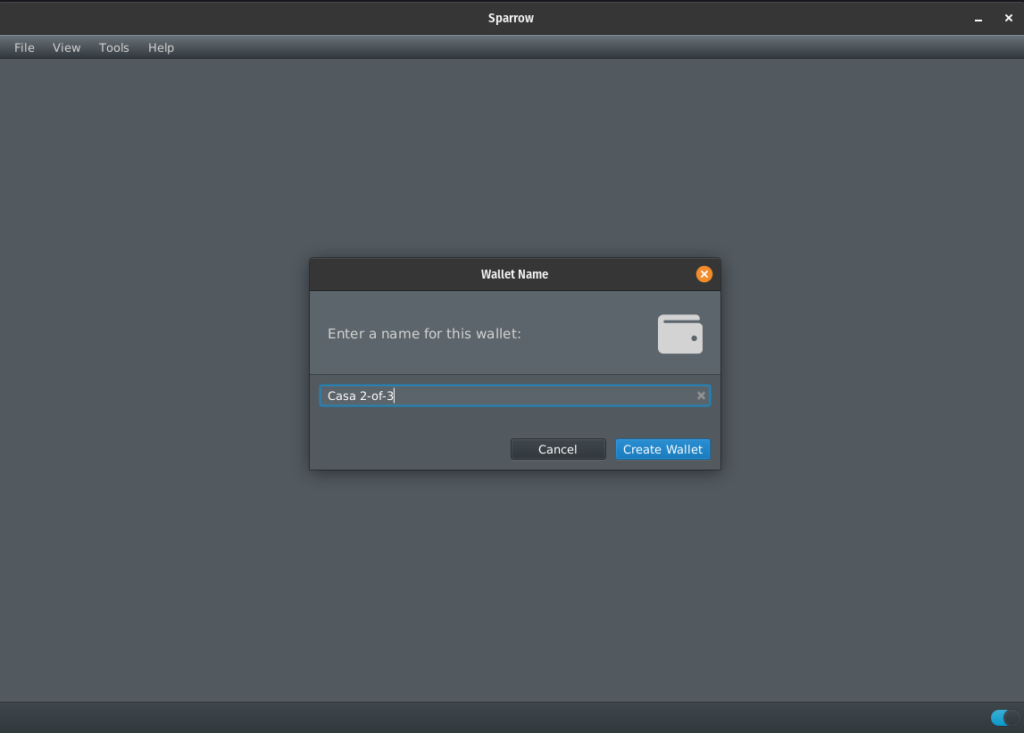
On the following screen, change the ‘Policy Type’ to Multi Signature, then change the ‘Script Type’ to Nested Segwit and finally, set ‘Cosigners’ to 2/3. This will set the wallet’s spending policy to match Casa where two signatures out of a possible three are required to spend from the wallet. If you are following this guide as a Platinum user, set ‘Cosigners’ to 3/5, where three signatures from a possible five are required to spend.

The next step is to import the information taken from the Casa app, into Sparrow. Sparrow represents each cosigner as a ‘Keystore’, and for the purposes of this guide, all three cosigners will be imported using the ‘xPub / Watch Only Wallet‘ option.
Populate the first Keystore using the information saved in your chosen transfer app, ensuring you enter each piece of information exactly as it was copied from Casa.
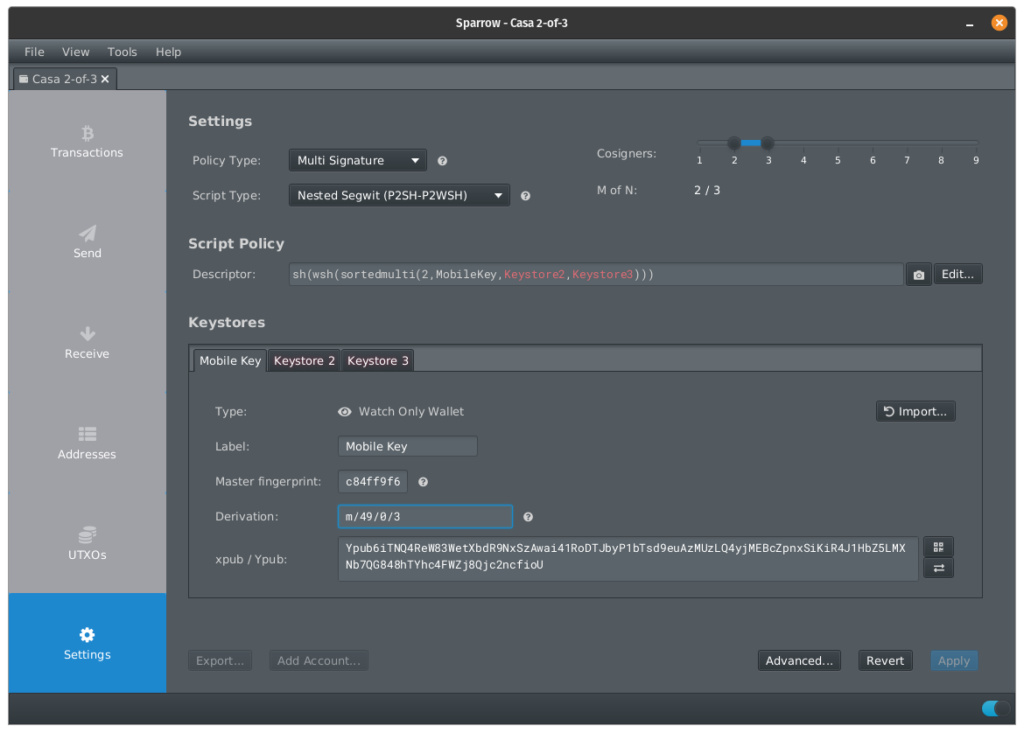
Repeat for all cosigners until each Keystore in Sparrow is populated. For the Casa Recovery Key, enter the same derivation path used for all other keys.
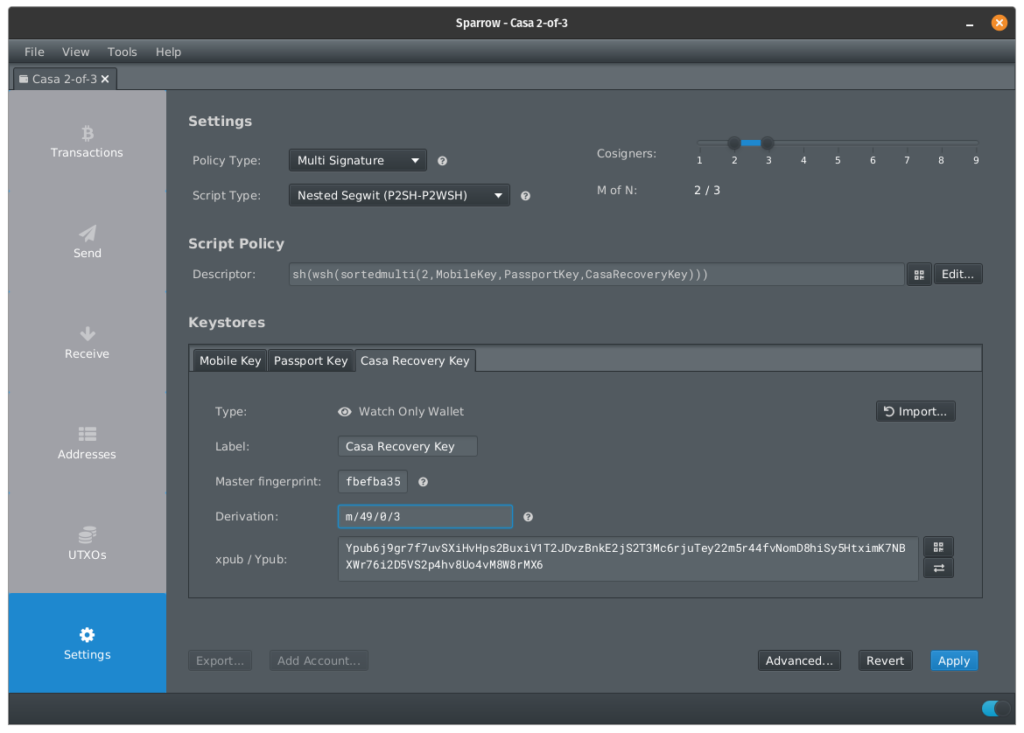
Once completed, click ‘Apply’. Sparrow will then ask if you’d like to set a password to prevent unauthorized access to the wallet. This password is unique to Sparrow and, if applied, ensure it is securely backup up.
Do they match?
If you followed these instructions successfully, opening the Transactions tab will reveal your Casa wallet’s total balance and transaction history. If you do not, open the Sparrow Settings tab and double check the information entered is an exact match to that shown in Casa.
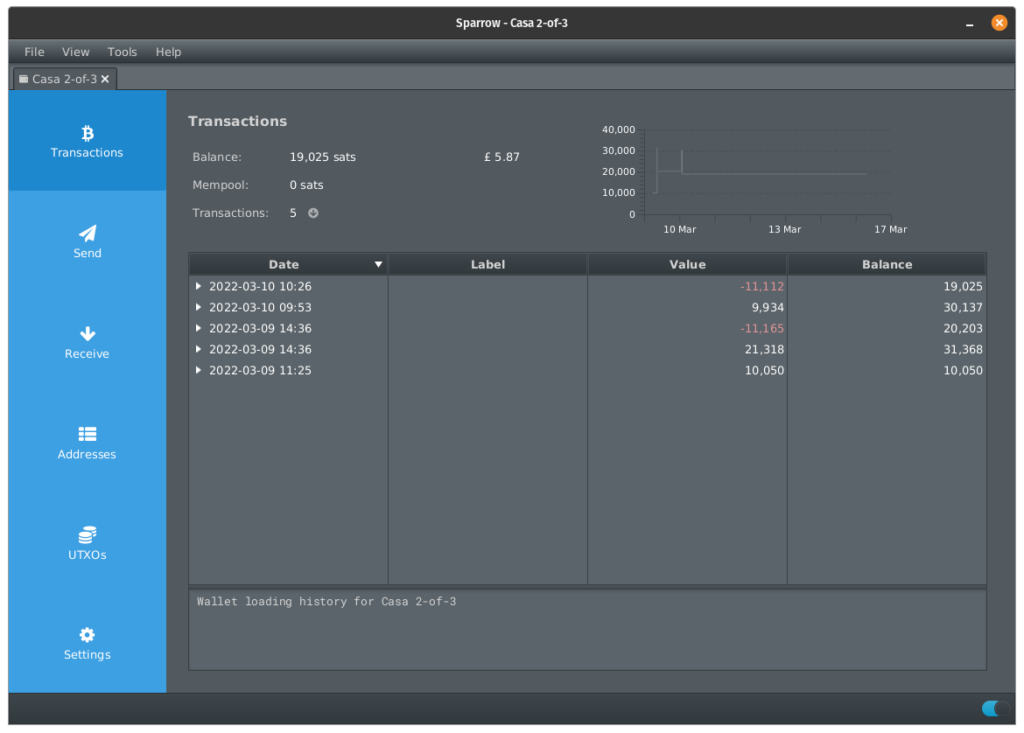
Open the Receive screen in both Casa and Sparrow and check that the addresses shown are an exact match. We can now be confident that Casa is generating the correct receive addresses for your multi-signature wallet. If desired, you can repeat this check every time the Casa app shows you a new receiving address.
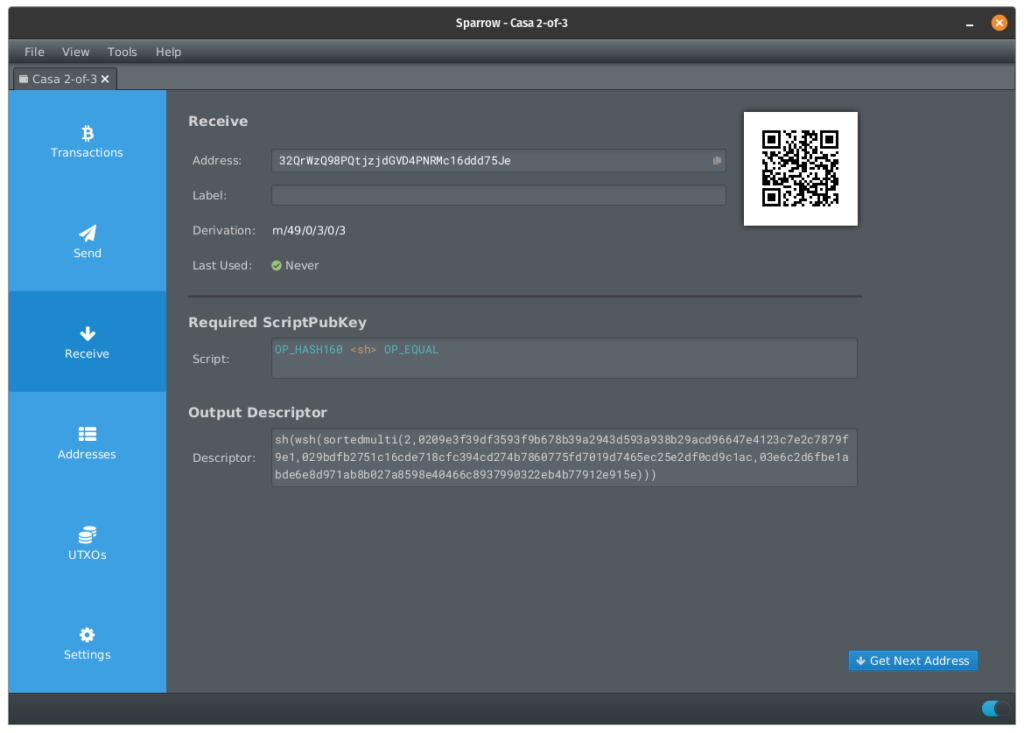
Verifying with passport
To leverage Passport’s powerful ‘Verify Address’ feature to verify all future addresses shown by Casa (or Sparrow) with a simple scan, we need to make Passport aware of the wallet configuration. Unlike other multisig wallet coordinators, Casa does not currently have a way to export this information via QR code or microSD card, but there are two other ways we can get this information to Passport.
Option 1 – Passport Multisig policy
By having Passport’s multisig policy set to ‘Ask to Import’, Passport will automatically pull the required information from the transaction details when signing a transaction with Casa.

option 2 – use sparrow
With the multisig wallet open in Sparrow, head to Settings > Export, then click ‘Show’ next to ‘Passport Multisig’. Sparrow will then display an animated QR code containing all of the wallet public information which will notify Passport of the wallet details.
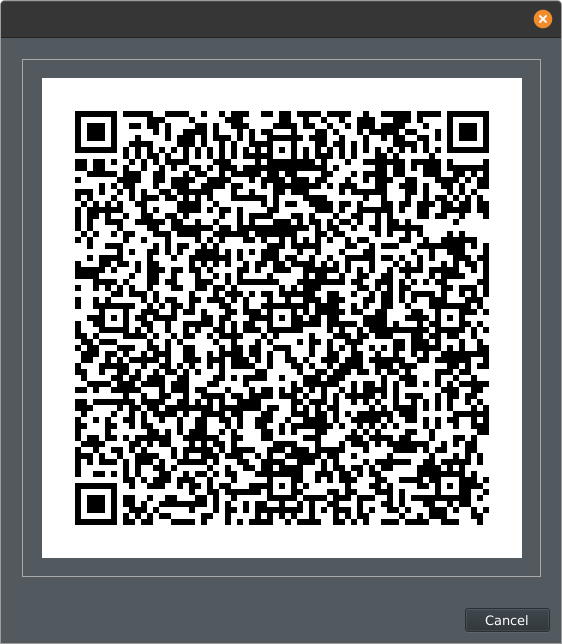
On Passport head to Settings > Multisig > Import from QR then scan the QR being displayed by Sparrow. Review the details shown on screen and then confirm.
scan + go
Now, when using the Verify Address feature on Passport, you’ll be able to choose your imported Casa wallet from the list and will get a confirmation that the address being shown is part of your multisig wallet.
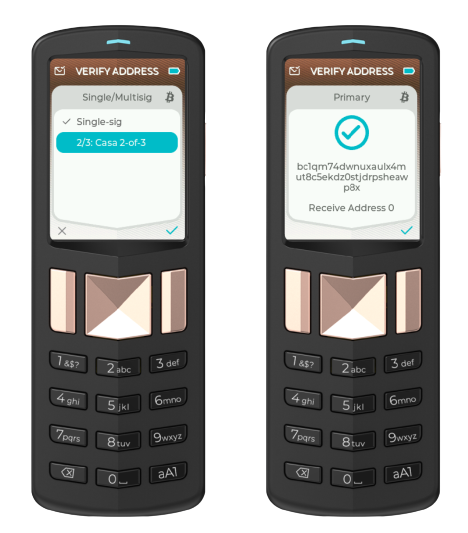
What if i want to spend?
At this stage Sparrow is acting purely as a watch-only wallet that cannot spend, and has no influence on the activities taken in the Casa app. The private keys required to authorize spends are still stored on your Passport, your phone and on the Casa Recovery Server respectively. But what if Casa were to disappear and you needed to move your Bitcoin?
In this very unlikely scenario, the steps required are almost identical to those outlined above. The only difference being, that instead of importing the Mobile cosigner’s public key, we instead need to import its private key. This private key can be exported from Casa by tapping on the mobile key then ‘Import or Export Backup’, followed by ‘Export Private Key’. Casa will then display a list of seed words that should be stored securely and not shared with anyone.
Once you have the mobile key’s seed words, you can change that Keystore in the Sparrow settings. Click ‘Import from an external source’, choose ‘Software Wallet’ then ‘Mnemonic Seed Words (BIP39)’. Then enter the seed words you noted down from the Casa app.
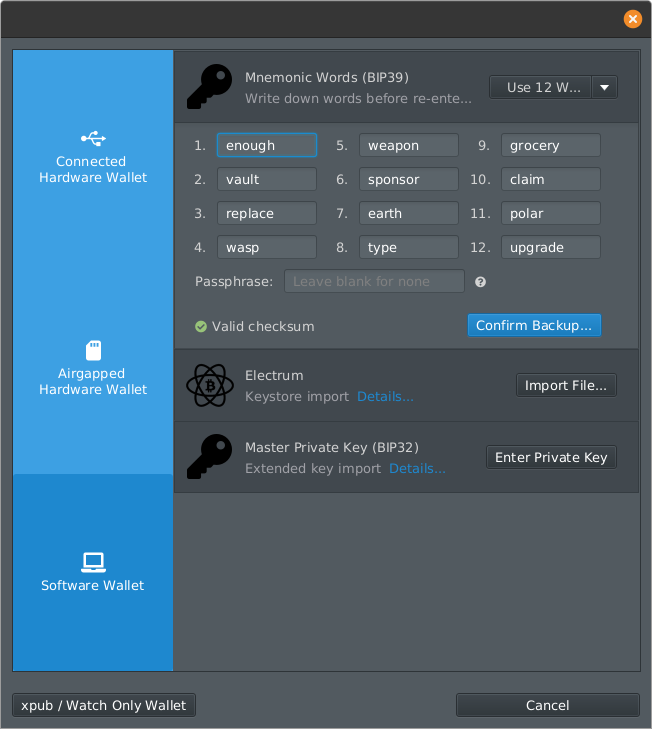
On the following screen set the derivation path to match the other cosigners and click ‘Import Custom Derivation Key’. To finalize these changes click ‘Apply’ on the settings screen.
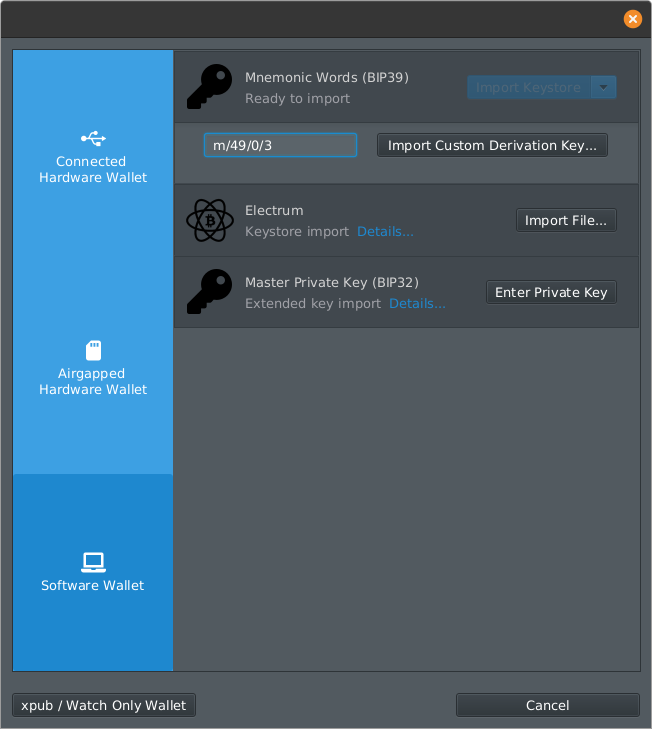
Sparrow now contains 1 of the 3 private keys required to spend from this multisig wallet. Now, to spend your Bitcoin to a new wallet, all that’s required is to create the transaction by following the usual steps and providing a second signature with Passport. The video below demonstrates the typical signing flow with Passport + Sparrow.
A note on key rotations
When one key is compromised and replaced, Casa bumps all other keys to the next account level in their respective derivation paths. This means that any time a key rotation is performed within Casa, the above steps must be repeated. More experienced Sparrow users may opt to manually update each Keystore to reflect the wallet changes, but it is good practice for newer users to get comfortable creating the wallet from scratch.
BONUS – coinjoin directly to your casa wallet!
Sparrow Wallet recently incorporated the Samourai Wallet Whirlpool coinjoin implementation. Conjoin is one of the best methods available to preserve your privacy when interacting with Bitcoin’s transparent ledger. Sparrow enables you to participate in coinjoins via your computer without the need for an Android phone. Additional to the Whirlpool functionality, Sparrow also enables users to have those mixed outputs be sent automatically to any another wallet managed by the same Sparrow application. No additional user input, just start the mix, leave Sparrow running and it will do the rest for you!
This section of the guide is not designed to be a detailed walk through of using Whirlpool with Sparrow. For that, you can read this guide or watch this video. Prerequisites for this section of the guide:
- Have a Casa wallet imported into Sparrow.
- Have a single signature hot wallet (where Sparrow holds the seed words) set up in Sparrow.
- Have the hot wallet funded with the amount of Bitcoin you want to coinjoin.
Starting the mix
With your hot wallet open in Sparrow and funded with the amount of Bitcoin you want to coinjoin, open the UTXO tab and from the list, select the UTXOs you want to mix. Then choose ‘Mix Selected’.

Work through the following dialogue screens to select your miner fee and pool size to enter. The pool size you choose will depend on the amount of Bitcoin you are mixing plus the desired denomination of mixed output you desire. To confirm click Preview Premix.
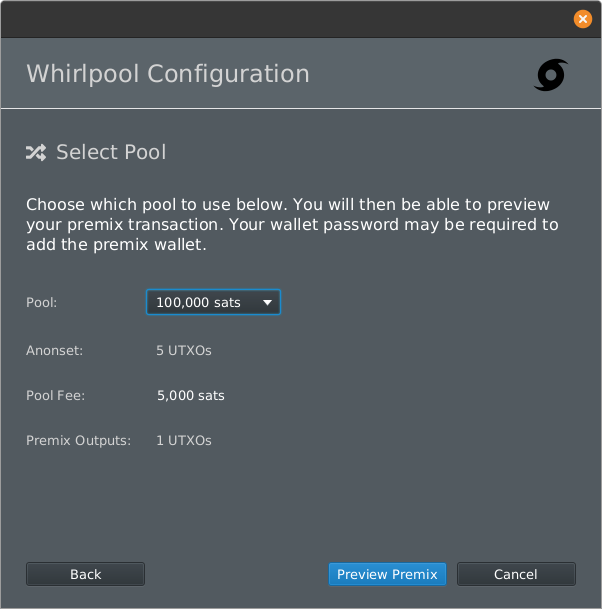
On the following screen Sparrow provides a breakdown of the fees involved and mixed outputs created from the coinjoin. When you are happy click Broadcast Premix Transaction.
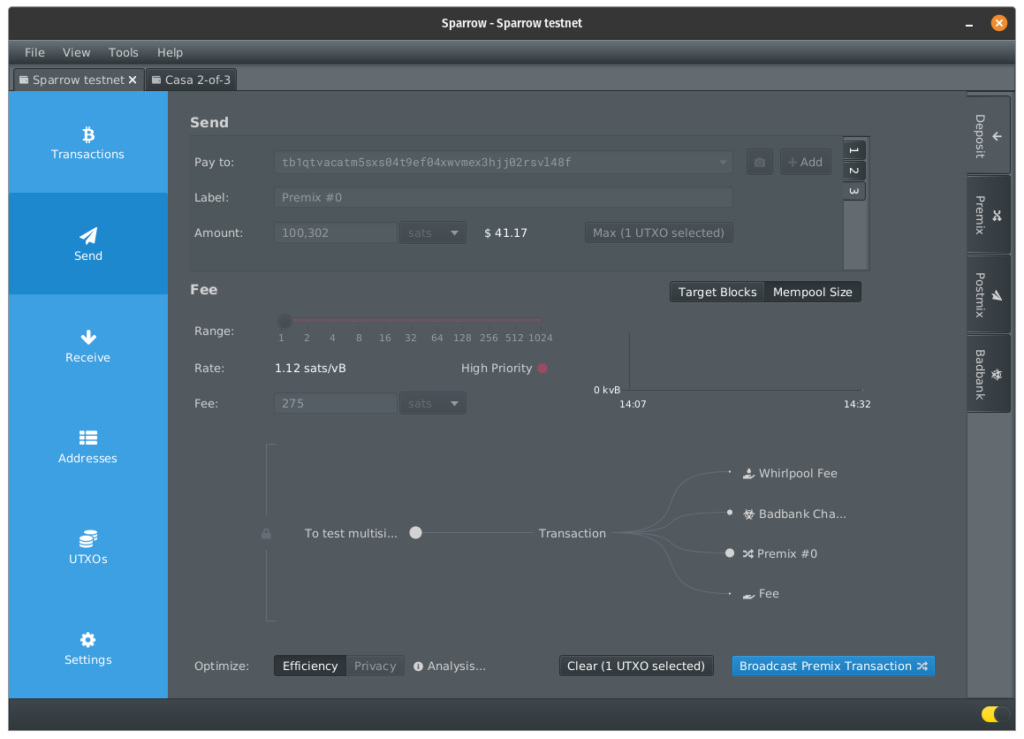
The coinjoin is now initiated and Sparrow will take over and do the rest for you, provided you keep the application running. After a short while, navigate to the Postmix tab from the side bar to see your mixed outputs. How many you see in this screen will depend on the amount of Bitcoin you elected to mix, and in which pool.
Mixing larger amounts in smaller pools may take longer to complete, so do not be alarmed the expected amount of Bitcoin does not show up immediately.
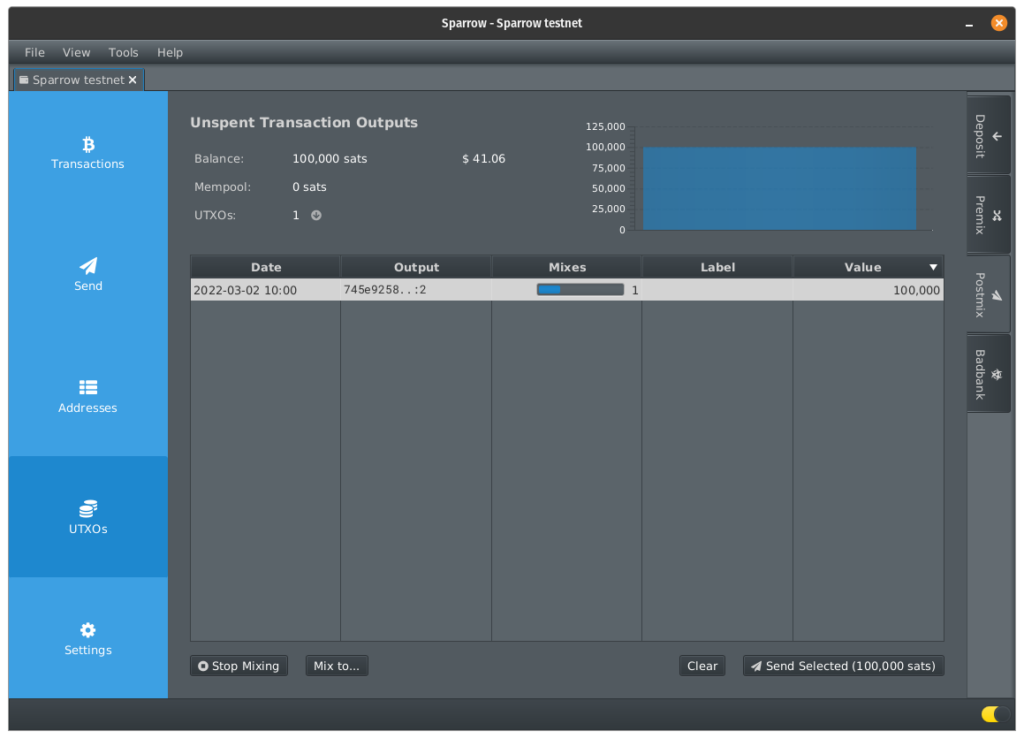
Mixing to your casa multisig
To get your mixed outputs sent automatically to your Casa multisig, ensure both your hot wallet and the imported Casa wallet are open in Sparrow. Then navigate to the Postmix UTXOs tab and select the UTXO(s) to be mixed into the Casa wallet then click ‘Mix to’.
In the pop up window, select the imported Casa wallet from the Mix to drop down then select the minimum number of mixes required before the UTXOs are eligible to be sent to the Casa wallet, a higher number here will improve your privacy but means the move to Casa will take longer. Finally, leave the index range to Full and click Restart Whirlpool.
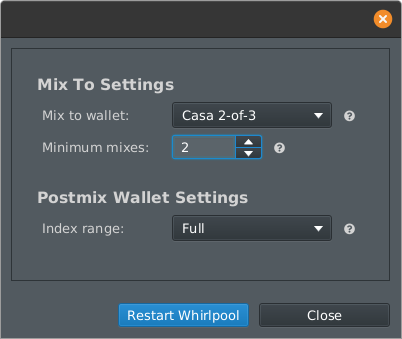
Now, when clicking on the UTXOs selected earlier, Sparrow will indicate at the bottom of the screen that they are ‘Mixing to Casa’. Again, all you need to do now is leave Sparrow running on your computer and it will take care of the rest for you.
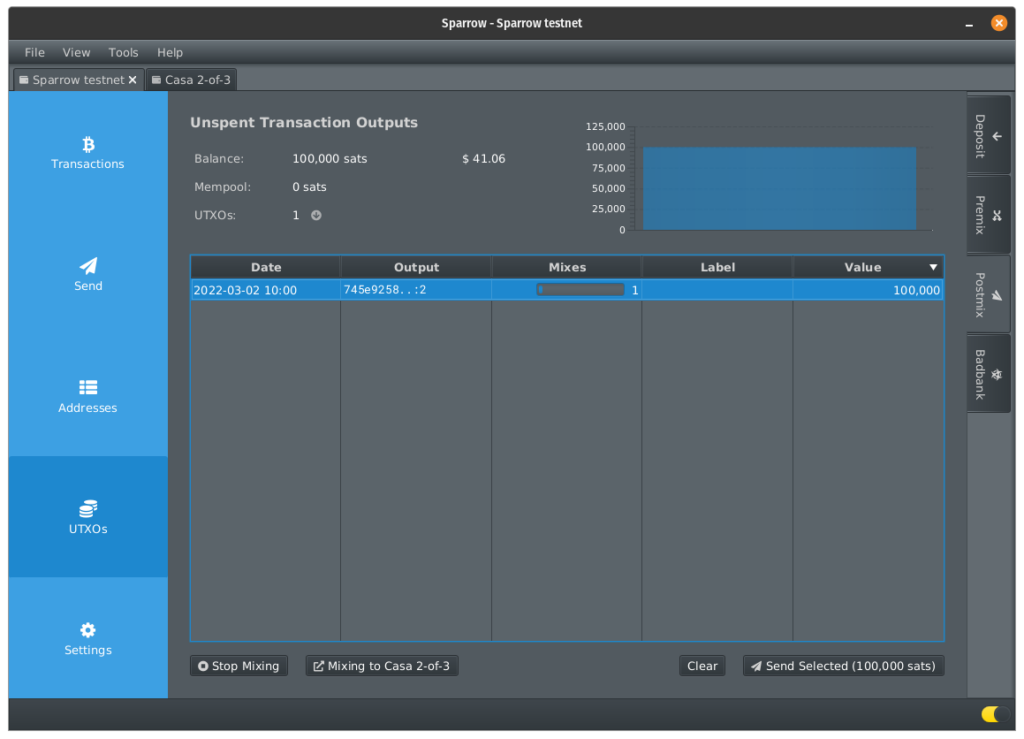
After the defined amount of mixes have taken place, you’ll see incoming transactions of the pool amount landing in your Casa app (and the imported version on Sparrow). Each UTXO will be sent individually to your Casa wallet, and the more UTXOs set using ‘Mix To’, the longer the process will take to fully complete. Patience is key here and you can monitor everything from Sparrow.
It’s worth mentioning that whilst Whirlpool provides fantastic forward looking privacy for your mixed outputs, your wallet is still ultimately connected to Casa’s node, meaning that Casa will still know the UTXOs are yours.
the best of both worlds
By following the steps outlined in this guide, you really can have have it all! You get the awesome security and redundancy the Casa collaborative custody model offers, coupled with the fantastic forward looking privacy gained from using the Whirlpool coinjoin service within Sparrow. All of this, whilst also minimizing the trust placed in Casa by combining Passport with a Sparrow watch-only setup to validate everything the Casa app presents to you. Finally, in the highly unlikely situation that Casa were to disappear, you’re now also fully prepared to recover your Bitcoin too.
Stay tuned to our YouTube and BitcoinTV channels for an upcoming video tutorial on using Passport with Casa to secure your sats!